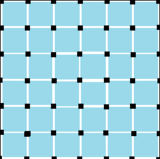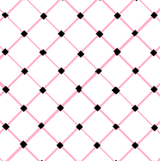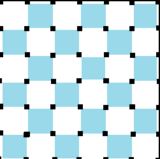Square tiling
| Square tiling | |
|---|---|
 | |
| Type | Regular tiling
|
| Vertex configuration | 4.4.4.4 (or 44) |
Face configuration |
V4.4.4.4 (or V44) |
| Schläfli symbol(s) | {4,4} {∞}×{∞} |
| Wythoff symbol(s) | 4 | 2 4 |
| Coxeter diagram(s) | |
| Symmetry | p4m , [4,4], (*442)
|
| Rotation symmetry | p4 , [4,4]+, (442)
|
| Dual | self-dual
|
| Properties | face-transitive
|

In
called it a quadrille.The
Uniform colorings
There are 9 distinct uniform colorings of a square tiling. Naming the colors by indices on the 4 squares around a vertex: 1111, 1112(i), 1112(ii), 1122, 1123(i), 1123(ii), 1212, 1213, 1234. (i) cases have simple reflection symmetry, and (ii) glide reflection symmetry. Three can be seen in the same symmetry domain as reduced colorings: 1112i from 1213, 1123i from 1234, and 1112ii reduced from 1123ii.
| 9 uniform colorings | |||||||||||
|---|---|---|---|---|---|---|---|---|---|---|---|
| 1111 | 1212 | 1213 | 1112i | 1122 | |||||||

|

|

|

|

| |||||||
| p4m (*442) | p4m (*442) | pmm (*2222) | |||||||||
| 1234 | 1123i | 1123ii | 1112ii | ||||||||

|

|

|

| ||||||||
| pmm (*2222) | cmm (2*22) | ||||||||||
Related polyhedra and tilings
This tiling is topologically related as a part of sequence of regular polyhedra and tilings, extending into the hyperbolic plane: {4,p}, p=3,4,5...
| *n42 symmetry mutation of regular tilings: {4,n} | |||||||||||
|---|---|---|---|---|---|---|---|---|---|---|---|
| Spherical | Euclidean | Compact hyperbolic | Paracompact | ||||||||
 {4,3} |
 {4,4} |
 {4,5} |
 {4,6} |
 {4,7} |
 {4,8}... |
 {4,∞} | |||||
This tiling is also topologically related as a part of sequence of regular polyhedra and tilings with four faces per vertex, starting with the octahedron, with Schläfli symbol {n,4}, and Coxeter diagram ![]()
![]()
![]()
![]()
![]() , with n progressing to infinity.
, with n progressing to infinity.
| *n42 symmetry mutation of regular tilings: {n,4} | |||||||
|---|---|---|---|---|---|---|---|
| Spherical | Euclidean | Hyperbolic tilings | |||||

|

|

|

|

|

|

|

|
| 24 | 34 | 44 | 54 | 64 | 74 | 84 | ...∞4 |
| *n42 symmetry mutations of quasiregular dual tilings: V(4.n)2 | |||||||||||
|---|---|---|---|---|---|---|---|---|---|---|---|
| Symmetry *4n2 [n,4] |
Spherical | Euclidean | Compact hyperbolic | Paracompact | Noncompact | ||||||
| *342 [3,4] |
*442 [4,4] |
*542 [5,4] |
*642 [6,4] |
*742 [7,4] |
*842 [8,4]... |
*∞42 [∞,4] |
[iπ/λ,4] | ||||
| Tiling Conf.
|
 V4.3.4.3 |
 V4.4.4.4 |
V4.5.4.5
|
 V4.6.4.6 |
 V4.7.4.7 |
 V4.8.4.8 |
 V4.∞.4.∞ |
V4.∞.4.∞ | |||
| *n42 symmetry mutation of expanded tilings: n.4.4.4 | |||||||||||
|---|---|---|---|---|---|---|---|---|---|---|---|
| Symmetry [n,4], (*n42) |
Spherical | Euclidean | Compact hyperbolic | Paracomp. | |||||||
| *342 [3,4] |
*442 [4,4] |
*542 [5,4] |
*642 [6,4] |
*742 [7,4] |
*842 [8,4] |
*∞42 [∞,4] | |||||
| Expanded figures |

|

|

|

|

|

|

| ||||
| Config. | 3.4.4.4 | 4.4.4.4 | 5.4.4.4 | 6.4.4.4 | 7.4.4.4 | 8.4.4.4 | ∞.4.4.4
| ||||
| Rhombic figures config.
|
 V3.4.4.4 |
 V4.4.4.4 |
 V5.4.4.4 |
 V6.4.4.4 |
 V7.4.4.4 |
 V8.4.4.4 |
 V∞.4.4.4 | ||||
Wythoff constructions from square tiling
Like the
Drawing the tiles colored as red on the original faces, yellow at the original vertices, and blue along the original edges, all 8 forms are distinct. However treating faces identically, there are only three topologically distinct forms: square tiling, truncated square tiling, snub square tiling.
| Uniform tilings based on square tiling symmetry | |||||||||||
|---|---|---|---|---|---|---|---|---|---|---|---|
| Symmetry: [4,4], (*442) | [4,4]+, (442) | [4,4+], (4*2) | |||||||||

|

|

|

|

|

|

|

| ||||
| {4,4} | t{4,4} | r{4,4} | t{4,4} | {4,4} | rr{4,4} | tr{4,4} | sr{4,4} | s{4,4} | |||
| Uniform duals | |||||||||||

|

|

|

|

|

|

|

| ||||
| V4.4.4.4 | V4.8.8 | V4.4.4.4 | V4.8.8 | V4.4.4.4 | V4.4.4.4 | V4.8.8 | V3.3.4.3.4 | ||||
Topologically equivalent tilings

Other quadrilateral tilings can be made which are topologically equivalent to the square tiling (4 quads around every vertex).

Isohedral tilings have identical faces (

|

|

|

|

|

|

|
| Square p4m, (*442) |
Quadrilateral p4g, (4*2) |
Rectangle pmm, (*2222) |
Parallelogram p2, (2222) |
Parallelogram pmg, (22*) |
Rhombus cmm, (2*22) |
Rhombus pmg, (22*) |
|---|---|---|---|---|---|---|

|

|

|

|

|

| |
| Trapezoid cmm, (2*22) |
Quadrilateral pgg, (22×) |
Kite pmg, (22*) |
Quadrilateral pgg, (22×) |
Quadrilateral p2, (2222) | ||

|

|

|

|

|

|
| Isosceles pmg, (22*) |
Isosceles pgg, (22×) |
Scalene pgg, (22×) |
Scalene p2, (2222) | ||
|---|---|---|---|---|---|
Circle packing
The square tiling can be used as a circle packing, placing equal diameter circles at the center of every point. Every circle is in contact with 4 other circles in the packing (kissing number).[2] The packing density is π/4=78.54% coverage. There are 4 uniform colorings of the circle packings.
Related regular complex apeirogons
There are 3
| Self-dual | Duals | |
|---|---|---|

|

|

|
| 4{4}4 or |
2{8}4 or |
4{8}2 or |
See also
- Checkerboard
- List of regular polytopes
- List of uniform tilings
- Square lattice
- Tilings of regular polygons
References
- ^ Tilings and patterns, from list of 107 isohedral tilings, p.473-481
- ^ Order in Space: A design source book, Keith Critchlow, p.74-75, circle pattern 3
- ^ Coxeter, Regular Complex Polytopes, pp. 111-112, p. 136.
- ISBN 0-486-61480-8p. 296, Table II: Regular honeycombs
- Klitzing, Richard. "2D Euclidean tilings o4o4x - squat - O1".
- ISBN 0-486-23729-X. p36
- ISBN 0-7167-1193-1. (Chapter 2.1: Regular and uniform tilings, p. 58-65)
- John H. Conway, Heidi Burgiel, Chaim Goodman-Strauss, The Symmetries of Things 2008, ISBN 978-1-56881-220-5 [1]
External links
- Weisstein, Eric W. "Square Grid". MathWorld.
- Weisstein, Eric W. "Regular tessellation". MathWorld.
- Weisstein, Eric W. "Uniform tessellation". MathWorld.
| Space | Family | / / | ||||
|---|---|---|---|---|---|---|
| E2 | Uniform tiling | {3[3]} | δ3 | hδ3 | qδ3 | Hexagonal |
| E3 | Uniform convex honeycomb
|
{3[4]} | δ4 | hδ4 | qδ4 | |
| E4 | Uniform 4-honeycomb
|
{3[5]} | δ5 | hδ5 | qδ5 | 24-cell honeycomb |
| E5 | Uniform 5-honeycomb
|
{3[6]} | δ6 | hδ6 | qδ6 | |
| E6 | Uniform 6-honeycomb
|
{3[7]} | δ7 | hδ7 | qδ7 | 222 |
| E7 | Uniform 7-honeycomb
|
{3[8]} | δ8 | hδ8 | qδ8 | 133 • 331 |
| E8 | Uniform 8-honeycomb
|
{3[9]} | δ9 | hδ9 | qδ9 | 152 • 251 • 521 |
| E9 | Uniform 9-honeycomb
|
{3[10]} | δ10 | hδ10 | qδ10 | |
| E10 | Uniform 10-honeycomb | {3[11]} | δ11 | hδ11 | qδ11 | |
| En-1 | Uniform (n-1)-honeycomb | {3[n]}
|
δn | hδn | qδn | 1k2 • 2k1 • k21 |










